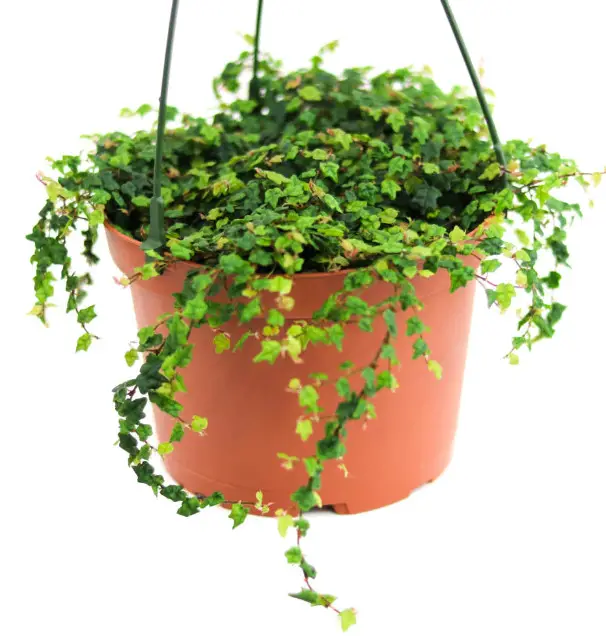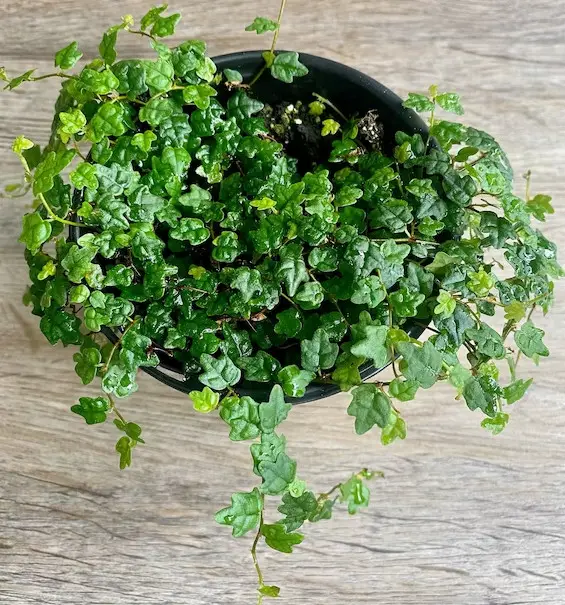The String of Frogs, scientifically known as Ficus pumila ‘Quercifolia,’ is a lovely houseplant that adds a unique touch to indoor and outdoor spaces. With its distinctive oak-shaped leaves, this evergreen ficus species is relatively easy to care for, making it an ideal choice for both novice and experienced plant enthusiasts
About the String of Frogs

A fascinating and long-lasting creeping ficus species is the String of Frogs, or Ficus pumila ‘Quercifolia,’ as it is officially named. It gets its name from the unique little oak-like leaves, which resemble frogs that are crouching. Its small, lobed leaves are quite similar to oak leaves, which is why it is commonly called the Oak leaf creeping fig. “Quercus,” which means oak, and “folium,” which means leaf, are the two Latin words that make up the phrase “Quercifolia.” The ficus, which is native to East Asian tropical and subtropical climates, shares the same shallow fibrous roots as its peers, resulting in smooth, cylindrical brown stems that trail and form a mat-like surface.
The leaves are about half an inch in size and have an olive green color with dark green veins. This non-flowering plant is frequently used as a terrarium plant and is grown for its magnificent lustrous foliage. The String of Frogs, once thought to be an uncommon houseplant, has gained popularity because of its easy replication, invasive nature, and broad availability in the market. It grows best in USDA hardiness zones 9 through 11, but it can also flourish in tropical and subtropical regions. It works well with hanging baskets, pots, and tiny containers indoors amid other collections or outside out of the direct sun.
The plant is usually medium-growing, however its pace of development depends on its surroundings. With the right care, it can survive for decades after maturing in two to three years. When unpruned, it can grow up to 3 meters tall and 5 meters wide. Unlike other houseplants in the same container, the trailing stems of this one require a bigger space because they grow beyond the pot.
How to care for the String of Frogs

The String of Frogs are easy to care for, but for best growth, a few important elements need to be considered. Keep the plant out of direct sunlight to avoid problems like scorching and leaf stains. Make sure the soil drains properly to prevent waterlogging, and water the soil only after the top two inches have dried. Keep the temperature between 20 and 30 degrees Celsius; in hotter weather, alter the frequency of watering as necessary. This plant needs a humid atmosphere to flourish, which can be provided by using a pebble tray method or a humidifier. It is appropriate to fertilize monthly and to repot every two to three years. Adapt training and pruning to the size and desired form of the plant.
Light
The String of Frogs thrives in partially diffused light. Prolonged exposure to direct sunlight can lead to leaf scorching and necrosis, making it ideal for locations under tree canopies with diffused light when outdoors. Indoors, position it on East or North-facing windowsills, or under artificial growing lights. Ensure adequate light to prevent the plant from becoming light-deficient, as low light can result in enlarged and distorted leaves. For optimal growth, the plant enjoys a morning sun bath.
Temperature
The ideal temperature falls between 20 and 30 degrees Celsius. Since it’s a tropical plant, it can withstand temperatures as low as 10 degrees Celsius and as high as 35 degrees Celsius. Within the ideal temperature range, it is beneficial to keep a cold, humid atmosphere.
Soil
In terms of soil preferences, the String of Frogs favors loamy or sandy loamy, friable, and well-drained soil with a neutral pH. Given its delicate roots, it is essential to avoid non-draining soil, as it can lead to waterlogging, potentially causing root rot and, ultimately, plant death.
To create an optimal soil mix, incorporate perlite, pumice, sphagnum moss, small pebbles, and organic matter. These additions enhance soil porosity and drainage capacity, ensuring a healthier environment for the plant.
Water
The plant loses less moisture than other tropical plants because it is kept out of direct sunlight. Thus, it will be beneficial to water the plant once a week. In periods of excessive heat, the frequency of watering should be increased; in the winter, it should be reduced to once every two weeks. Recall that the soil need to be damp but not drenched.
Depending on the temperature range in your area, you can plan a watering schedule. Dipping your finger into the dirt will also tell you when to water it. Use a 2-centimeter earth dip to do this with your finger. It is not necessary to water if the dirt is on to your finger. The dirt is dry and it’s time to water your string of frogs if your fingers come out clean. Without applying pressure on the stem, watering should be done at the root level. Between irrigations, let the soil to dry out.
Humidity
Tropical plants like chilly, humid environments among other characteristics. A string of frogs also favors between 60% and 80% humidity. Turgidity brought on by high humidity makes the leaves appear shiny. However, it can also endure low humidity.
In low-humidity environments, you can maintain the humidity level surrounding the plant by spraying it, using a humidifier, or using a pebble tray approach.
Fertilizer
If your soil contains sufficient organic matter, fertilizing the plant once a month will guarantee healthy plant growth but is not a must. A diluted liquid fertilizer solution can be applied once a month, ideally in the spring and summer when growth is more rapid.
Potting and Repotting
This evergreen plant should be potted in the same manner as other houseplants. First, select a pot size based on the amount of space in your home and the desired growth rate of the plant. Drainage can also be facilitated by using earthen pots with a drainage hole. Reserve a few tiny bricks or pebbles, then fill in the prepared, well-draining soil mixture. After the rooted plant is planted, the soil is kept damp beneath a canopy of shade.
Since the plant matures slowly, repotting can be done in two to three years, after the nutrients in the soil have been depleted. When repotting, a larger pot is selected, and the fresh soil needs to be nutrient-rich.
Training and Pruning
Pruning can be performed as needed to remove diseased or dead twigs. Training the plant can be conducted annually or semi-annually, depending on the desired size and shape. The String of Frogs tends to exhibit accelerated growth following training and pruning.
Methods of propagating String of Frogs
This climbing fig can be multiplied by seeds, stem cuttings, and leaf cuttings. Among them, stem cutting is the most used technique.
Through seeds
It involves germination to grow the plant straight from the seeds. First things first, make sure the soil mix is moist and well-drained. After the seeds are introduced into the prepared soil mix, the pot should be placed in a warm area with diffused sunshine for two to three weeks, or until the roots begin to take hold. After that, you can move the rooted plants to the appropriate spots.
Through leaf clippings
To grow a leaf by leaf cuttings, you should first select a healthy leaf with plenty of lobes. After cutting the leaf and removing the petiole, the cut part needs to be soaked in a rooting hormone. Plant the leaf cuttings into the well-drained potting mix after dipping. After giving it a small amount of water to keep it moist, leave it in the shade until the root grows, which should happen in two to eight weeks. After that, the rooted plants can be moved to different pots and locations.
Through stem cuttings
The simplest and most dependable approach is using stem cuttings to propagate the String of Frogs. To carry out:
Choose a healthy stem with two to three nodes to start, then clip the stem below the node. Choosing stems that already have roots increases the chances of cuttings succeeding.
Prepare a moist, well-draining substrate and cover it with a layer of sphagnum moss.
After dipping the cutting in rooting hormone, insert it into the medium, making sure the node that needs to be rooted is inside.
Until the roots process begins, moisten the substrate and place the pot in a humid area with diffused sunshine or under grow lights.
After two to six weeks, transplant the rooted cuttings and cultivate them as usual.
How much does String of Frogs cost?
The amount of leaves, pot size, shipping distance, and other factors affect the potted plant’s pricing. The price often falls between $7 to $30. Online retailers like Amazon, Walmart, and the stores’ own websites are among the places you can get it.
Notes when growing String of Frogs
This kind of Ficus is harmful to people and animals, including dogs and cats, therefore before obtaining it, carefully consider any potential effects. The plant produces milky latex, which can cause allergies and skin discomfort. It is important to handle this material carefully and keep it away from children and dogs as direct contact can result in blisters, burns, and irritation. It’s important to wear gloves or wash your hands thoroughly after tending to the plant. Moderately hazardous symptoms, such as vomiting, diarrhea, skin inflammation, stomach pain, decreased appetite, dermatitis, and convulsions, may arise after ingestion. If symptoms appear, get prompt medical attention from clinics or hospitals in the area.
Conclusion
The String of Frogs is a lovely houseplant with distinctive aesthetics that is also quite easy to maintain. Following care instructions guarantees its thriving existence, which makes it a lovely accent to any area.
People Who Read This Also Read:






